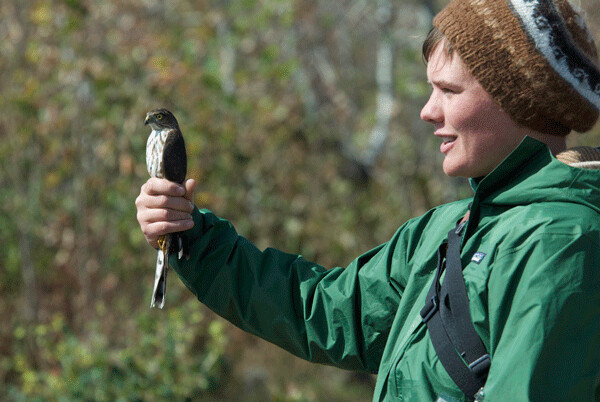Sharpies at Hawk Ridge

A blustery northwest wind cut right through two layers of wool as I stepped out of the car at Hawk Ridge in Duluth, MN. Binoculars, bird books, hot tea, and windbreakers in hand, my parents and I set up our watch with about fifty other birders and volunteers. Bright sunshine alternated with shadows cast by hurried gray clouds. Up on a wooden platform, several experts peered through spotting scopes, intently searching the sky. Their quarry: hawks.
Each fall, about 82,000 raptors pass over Hawk Ridge on their southern migration. Understandably reluctant to cross a large body of water, the birds funnel southwest along the shore of Lake Superior. The high, rocky outcrop of Hawk Ridge Nature Reserve makes a great viewing platform, and people from all over (like my parents from Iowa) come to watch the migration here.
Under some conditions, hawks will fly low over the ridge, zooming just above the heads of excited birders. Today, most of the raptors were tiny black specks in the distance, only visible by scanning the wild blue yonder with our binoculars.
Raptor biologists here have a special trick for getting close-up views of the hawks – bait. Using a technique a lot like fishing, researchers pull the string on a lure to make it look like an injured bird. When a raptor swoops down for an easy meal, it becomes tangled in one of a series of nets. Researchers carefully extricate it from the net, take a variety of measurements, and attach a numbered band to its leg. About three percent of birds banded here are recaptured. Based on the data collected from recapturing banded birds, sharp-shinned hawks migrating over Hawk Ridge generally head southeast to Illinois, and then southwest toward east Texas and Mexico, following the prevailing wind pattern.
Sometimes naturalists bring a recent captive down from the remote banding station so that folks on the overlook can get a better view. Moments after we arrived, two naturalists called everyone over to see a couple “sharpies” in hand. To prevent the hawks from hurting the humans or themselves, the naturalists held their wings, tail, and legs gently but firmly in the fist of one hand. The birds, both hatch-year females, looked quite calm.
Sharp-shinned hawks are the smallest hawks in North America, and have the biggest size difference between males and females. Females are up to one-third bigger than males, and this size difference means that they focus on different sizes of prey. Males tend to hunt smaller birds, such as sparrows, while females can concentrate on larger prey, like robins. This has two big advantages: males and females do not compete for the same food source, and chicks can get appropriately sized food as they grow.
During the first few weeks after hatching, the female sharp-shin broods the chicks while the male hunts and brings in small songbirds. He typically removes and eats the head before delivering the meal. As the chicks mature, the female joins in the hunting and brings larger prey for the hungry fledglings.
Sharp-shinned hawks are agile and acrobatic fliers, navigating dense woods at high speeds by using their long tail as a rudder. Short, rounded wings help them zip through tight spaces after small birds. During migration, they leave the dense forests of their northern nesting grounds and take to the open sky.
To help make the journey easier, these and other hawks will ride thermals, which are rising pockets of warmer air, formed by the uneven heating of the surface of the Earth. Thunderheads are visible thermals, where clouds of water droplets show just how high the warm air is climbing. When you see turkey vultures or other birds soaring in lazy circles without flapping, they are riding thermals.
For every mile a bird rises on this avian elevator, it can coast downwind seven miles without flapping. Still, sharp-shinned hawk’ migration from the top of this continent to the bottom takes strength, endurance, and stored energy. In order to be ready for the journey, these small hawks grow furiously—going from egg to adult size in just over 7 weeks.
The Hawk Ridge naturalists spent a few minute answering questions, and then asked for a volunteer to release the bird. In a flurry of feathers, the hawk left the visitor’s hand. It swooped below the cliff for a moment, giving us a spectacular “birds-eye view.” With a series of graceful circles, the sharpie gained altitude. Soon the little hawk was a mere speck in the sky, one of the many birds on an incredible journey, visible only through our scanning binoculars.
If you would like more information on the migration at Hawk Ridge, visit their website: www.hawkridge.org. You can also join Museum Naturalist, Haley Appleman on a Hawk Ridge field trip on September 27. Call 715-798-3890 or visit cablemuseum.org for the details and to register.
Author’s Note: This article was originally published in 2012.
Special Note: Emily’s book, Natural Connections: Exploring Northwoods Nature through Science and Your Senses is here! Order your copy at http://cablemuseum.org/natural-connections-book/. Listen to the podcast at www.cablemusum.org!
For 50 years, the Cable Natural History Museum has served to connect you to the Northwoods. Come visit us in Cable, WI! Our new exhibit: “Better Together--Celebrating a Natural Community” is now open!
